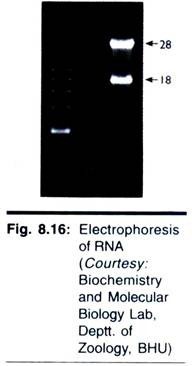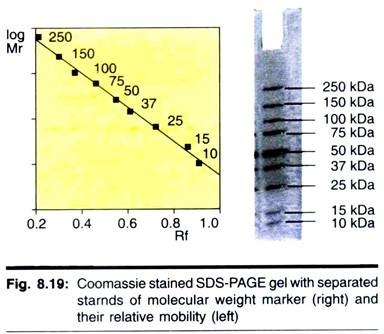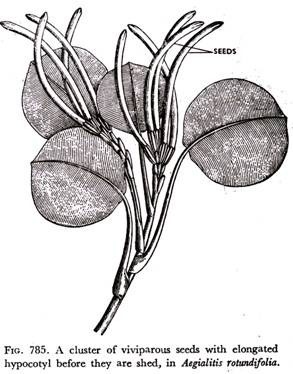In this article we will discuss about Fatty Acids. After reading this article you will learn about: 1. Subject-Matter of Fatty Acids 2. Enzymatic Degradation of Fatty Acids 3. β-Oxidation 4. Biosynthesis 5. Reactions.
Contents:
- Subject-Matter of Fatty Acids
- Enzymatic Degradation of Fatty Acids
- β-Oxidation of Fatty Acids
- Biosynthesis of Fatty Acids
- Reactions of Fatty Acid Synthetase Complex
Contents
1. Subject-Matter of Fatty Acids:
Fatty acids which occur in neutral fats are straight-chain carboxylic acids and usually contain an even number of carbon atoms (Table 11.1).
The structure is derived from 2-carbon (C2) units, i.e., acetyl residues which are utilized as building blocks in their biosynthesis. The chain may be saturated without double bonds or unsaturated containing one or more double bonds. Branched chain fatty acids do not seem to occur in higher plants.
Most prevalent saturated fatty acids are with 16 and 18 carbon atoms:
Palmitic acid (C16H 32 O2) and stearic acid (C18H36O2). Among the saturated fatty acids, lauric acid (C12), myristic acid (C14) and arachidic acid (C20) represent further constituents of neutral fats in plants.
Unsaturated fatty acids also occur in neutral fats. These compounds have one, two or more double bonds in the hydrocarbon chain. The C18 compounds of oleic acid (C18H34O2), linoleic acid (C18H32 O2), linolenic acid (C18H30O2) and C20 compound of arachidonic acid (C20H32O2) belong to this group (Table 11.2).
Unsaturated fatty acids with ring structures or polar functions in the molecule have also been identified in fats. Examples are sterculic acid, lactobacillic acid and chalmoogric acid.
2. Enzymatic Degradation of Fatty Acids:
During germination of fatty seeds, the fat or lipid content decreases rapidly with the production of soluble compounds. At the same time, the enzyme lipase, which specifically catalyzes fat cleavage, shows increased activity. According to the mode of action, lipases are classified as hydrolases belonging to the group esterases.
They cleave the ester bonds in fat molecules accompanied with uptake of water. First, diglycerides (either 1,3-diacylglycerol or 2,3-diacylglycerol) and subsequently monoglycerides (usually 2-acylglycerol) are formed as intermediates. After long exposure to the enzyme, however, free fatty acids and glycerol are finally formed.
The two cleavage products enter various metabolic pathways. Glycerol passes on to the carbohydrate metabolism and may be converted to sucrose via triose and hexose phosphates. Glycerol may also be degraded to dihydroxyacetone phosphate and pyruvic acid by the reaction sequences of glycolysis and citric acid cycle.
Long-chain fatty acids are degraded mainly by a special enzyme-catalysed mechanism termed β-oxidation yielding C2 fragments as acetyl CoA which enter various metabolic processes. It is reported that α-oxidation is of less importance in fatty acid degradation. The activated C2 fragment (acetyl CoA) serves as a substrate of the TCA cycle and is used in energy production through respiratory electron transport chain.
It may also be used in various synthetic processes through the intermediates of the citric acid cycle (Fig. 11.1). The acetyl CoA may also enter the glyoxylate cycle whose reactions are characteristic for fat-containing tissues of higher plants and thereby initiates a rapid synthesis of sucrose, the transport form of carbohydrate.
Thus, a link between lipid metabolism and carbohydrate metabolism can be maintained in the cell by this process of gluconeogenesis (i.e., new glucose synthesis).
3. β-Oxidation of Fatty Acids:
Since the β-carbon of the straight chain fatty acid is involved in the reaction sequence leading to the release of a terminal C2 unit, the process has been termed β-oxidation. It was discovered by F. Knoop in 1905 but the details were elucidated later through the studies of F. Lipmann, F. Lynen, D.E. Green, A.L. Lehninger and others.
The initial reaction is an activation of fatty acid molecule which is converted to an active intermediate (active fatty acid) in a reaction with ATP before it is further metabolized. This is the only step in the complete oxidation of fatty acid that is dependent on energy from ATP.
The enzyme acylthiokinase (acyl CoA synthetase) catalyses in presence of ATP and coenzyme A the conversion of a fatty acid to the high-energy acyl derivative of CoA in which one high-energy phosphate bond is consumed.
Inorganic pyrophosphate (PP,) formed in the activation reaction is hydrolysed to inorganic phosphate (Pi) by pyrophosphatase accompanied by the loss of the additional high-energy phosphate bond of pyrophosphate.
Thus, it is quite apparent that the activation of each fatty acid molecule requires the expenditure of two high-energy phosphate bonds. Long chain of acyl CoA cannot pass through the inner mitochondrial membrane to enter the matrix which is the site of fatty acyl CoA oxidation. Carnitine (β-hydroxy-γ-trimethylammonium butyrate) acts as a carrier of acyl groups into and out of mitochondria.
First, long-chain acyl groups are converted to acyl carnitine by an enzyme carnitine acyl transferase present on the outer side of inner mitochondrial membrane.
Acyl carnitine is able to penetrate the mitochondrial membrane and after its transport reacts with mitochondrial CoA whereby the acyl group from acyl carnitine is transferred to reform acyl CoA compound in the mitochondrial matrix by a second carnitine acyl transferase attached to the inside of the inner membrane and carnitine is liberated.
This process helps to keep separate the cytoplasmic and mitochondrial pools of CoA.
All the subsequent reactions of fatty acid oxidation take place in the inner compartment of the mitochondrion. In the first reaction of the β-oxidation pathway, two hydrogen atoms are removed from 2 (α)- and 3 (β)-carbon atoms, catalysed by acyl CoA dehydrogenase which is a flavoprotein containing FAD as the prosthetic group.
There is a specific dehydrogenase for each of different chain lengths. The flavoproteins transfer the hydrogen to the respiratory chain and after re-oxidation may take part in fatty acid degradation again. The product is Δ2-trans enoyl-CoA in which the position of the double bond is designated by Δ2.
In the next step involving hydration, water is added to the unsaturated fatty acid derivative of CoA to form β-hydroxyacyl CoA by the enzyme Δ2-enoyI CoA hydratase.
Then the second dehydrogenation occurs in which β-hydroxyacyl CoA is dehydrogenated to form 3(β)-ketoacyl CoA. The reaction is catalyzed by β-hydroxyacyl dehydrogenase with NAD as coenzyme.
The last reaction is the cleavage step in which the β-ketoacyl thioester being unstable readily releases a C2 fragment as acetyl CoA while the residual part of the fatty acid now shorter by two carbon atoms reacts with a free molecule of CoA-SH forming its CoA thioester. β-ketoacyl CoA acetyl transferase which is commonly known as thiolase acts as the specific enzyme.
This thiolytic cleavage is the key reaction step in the oxidation process because the -C-C- bond in the molecule is split. From the energy point of view, it is also important because the released C2 fragment remains bound to CoA as activated acetic acid, and the remaining part leaves the cleavage reaction as an acyl CoA compound having high energy potential.
Since the free energy of the reaction is largely conserved in chemical bond energy, no further activation is thus required. Activation is thus restricted to the initial reaction alone in which a fatty acid molecule independent of its chain length is bound to CoA.
Energy Balance of the Overall Process:
Although there is no direct gain of energy in the overall process in the form of ATP, hydrogen bound to specific electron transport molecules is provided for oxidation by the respiratory chain, thus yielding energy. In one turn of fatty acid oxidation cycle, one molecule of acetyl CoA is formed with 2(H) bound to NAD and 2(H) bound to the FAD system.
Since oxidation of one mole of NADH+ H+ via the respiratory chain yields three moles of ATP and oxidation of one mole of FADH2 yields two moles of ATP, a total of five moles of ATP results from each acetyl residue. For the complete oxidation of palmitic acid (16-C), seven cleavage steps or seven turns of the cycle will be required because the last turn will result in the production of two C-2 units, i.e., acetyl CoA.
If we start from palmitoyl CoA, the reactions of β-oxidation may be summarized as follows:
In seven turns of the cycle, one mole of palmitoyl CoA will be converted into eight moles of acetyl CoA.
These will yield 7×5 = 35 moles of ATP. Since two molecules of ATP are in effect utilized to form palmitoyl CoA from palmitate in the initial activation step, a net yield of 35-2 = 33 moles of ATP results from the degradation of one mole of palmitic acid to eight acetyl CoA fragments.
The latter is completely oxidized via citric acid cycle and respiratory electron transport chain which yield an additional 8 x 12 = 96 moles of ATP. Thus, the complete oxidation of one mole of palmitic acid to CO2 and H2O should yield a total of 33 + 96 = 129 moles of ATP. The efficiency of the process can be easily calculated since we know the free energy change (ΔG’) of complete combustion of palmitic acid.
This is the free energy change during the partial conservation of the released energy into ATP. The released energy is partially conserved in the form of ATP.
Since the formation of one mole of ATP from ADP and Pi requires the input of 7.3 kCal (same amount of energy is released upon ATP hydrolysis), the energy requirement for the formation of 129 ATP molecules will be as follows:
Thus, about 942/2340 x 100 = 40% of free energy of oxidation of palmitic acid is conserved as high-energy phosphate.
(a) α- and ω-Oxidation of Fatty Acids:
Although β-oxidation is the most important pathway for fatty acid oxidation, two other types of oxidation, viz., α- and ω-oxidation may also occur.
α-Oxidation of long-chain fatty acids has been shown to occur in cotyledons and young leaves, it involves elimination of one carbon at a time from the carboxyl group by oxidation with H2O2, catalysed by a fatty acid peroxidase and subsequent oxidation of the aldehyde compound formed (shortened by one C atom) by a dehydrogenase. It does not require CoA intermediate and does not generate high-energy phosphate.
ω-Oxidation is a minor pathway occurring in animal tissues. The initial reaction is brought about by a mono-oxygenase (hydroxylase) enzyme involving cytochrome P-450, NADPH and O2. The CH3 group is converted to a CH2OH group that is subsequently oxidized to COOH group thus forming a α, ω-dicarboxylic acid. This undergoes β-oxidation according to the usual sequence.
4. Biosynthesis of Fatty Acids:
In contrast to fatty acid oxidation, which takes place in the mitochondria, the major site of fatty acid synthesis is the cytosol. However, a system for fatty acid synthesis may exist in mitochondria which is responsible only for the elongation of existing fatty acids of medium-chain length.
A second type of chain elongation system may also be present in the membranes of the endoplasmic reticulum. In the initial reaction, CO2 is bound to acetyl CoA with the consumption of ATP leading to the production of malonyl CoA.
The enzyme acetyl CoA carboxylase is involved in this reaction and the vitamin biotin serves as the coenzyme which may be covalently bound to the enzyme protein. The first reaction step consists of an activation of carbonic acid which is bound to biotin with concomitant cleavage of ATP. The product CO2-biotin carboxylase is thus raised to a higher energy level and is able to react with acetyl CoA as an ‘active C1 fragment’.
(a) Source of Carbons for Fatty Acid Biosynthesis:
Acetyl Coenzyme A is the source of all the carbon atoms of fatty acids. Acetyl CoA is formed in the mitochondria either by the oxidative decarboxylation of pyruvate by the β-oxidation of long- chain fatty acids or by the oxidative degradation of some amino acids.
Acetyl CoA itself is not able to pass out of the mitochondria into the cytosol. Instead, citrate formed in mitochondria from acetyl CoA and oxaloacetate in TCA cycle can pass through the mitochondrial membrane to the cytoplasm with the help of the tricarboxylate transport system and can serve as a precursor of extra-mitochondrial acetyl CoA for fatty acid biosynthesis.
In the cytosol, acetyl CoA is again formed from citrate through ATP-citrate lyase, which is also called citrate- cleavage enzyme:
Citrate + ATP + CoA → Acetyl CoA + Oxaloacetic acid + ADP + Pi
This reaction is an example in which tricarboxylic acid cycle shows an amphibolic nature and functions not only in catabolism but also generates precursors for anabolic pathways. In an alternative pathway mentioned earlier in discussion on β-oxidation of fatty acids, the acetyl group of acetyl CoA is enzymatically transferred to carnitine which is a carrier of fatty acids into mitochondria for their oxidation.
Acetyl-carnitine, so formed, now passes through the mitochondrial membrane into the cytosol. Then the acetyl group is transferred from acetyl-carnitine to cytosol CoA and acetyl CoA is thus regenerated.
5. Reactions of Fatty Acid Synthetase Complex:
There are six individual enzymes of the fatty acid synthetase complex and the acyl radicals are attached with another protein called the acyl carrier protein (ACP) having no enzyme activity.
ACP contains the vitamin pantothenic acid in the form of 4-phosphopantetheine which contributes the single sulphydryl group similar to that of CoA from which it is derived. In fatty acid synthesis. ACP is utilized in place of CoA which functions in oxidation.
The following sequence of reactions takes place with acetyl CoA as the priming molecule:
(i) Reaction Catalysed by Acetyl Transacylase:
Initially, acetyl CoA combines with a serine hydroxyl of the enzyme
Acetyl-S-CoA + OH-Ser-Enz → Acetyl-Ser-Enz + CoA-SH
Then the acetyl group is transferred to the sulphydryl (SH) group of the ACP part of the enzyme complex.
Acetyl-Ser-Enz + ACP-SH →Acetyl-S-ACP + Ser-Enz
Then the acetyl group leaves ACP and is transferred to the cysteine-SH group of the condensing enzyme, β-ketoacyl-ACP synthase.
Acetyl-S-ACP + condensing enzyme-SH → Acetyl-S-condensing enzyme + ACP-SH …(1)
(ii) Reaction Catalyzed by Malonyl Transacylase:
In this step involving malonyl transfer reaction, malonyl CoA synthesized from acetyl CoA by acetyl CoA carboxylase, reacts with SH group of ACP to form malonyl-S-ACP and free CoA is released.
Malonyl-S-CoA + ACP-SH → malonyl-S-ACP + CoA-SH …(2)
By means of reactions 1 and 2, an acetyl group is esterified to —SH group on β-ketoacyl-ACP synthase enzyme molecule and a malonyl group is esterified to the —SH group of ACP of the enzyme complex.
(iii) Reaction Involving Condensation by β-ketoacyl-ACP Synthase:
With the help of β- ketoacyl-ACP synthase, the acetyl group esterified to cysteine-SH group of this enzyme is transferred to C-2 of the malonyl group esterified to ACP and the product of condensation is acetoacetyl-S-ACP (i.e., β-ketoacyl-ACP).
In this reaction, CO2 is liberated from the free carboxyl group of malonyl-S- ACP and this decarboxylation occurring during insertion of each 2-C unit into the growing fatty acid chain drives the reaction to completion.
(iv) The First Reduction Reaction by β-ketoacyl-ACP Reductase:
Acetoacetyl-S-ACP formed in the condensation reaction is now reduced to β-hydroxybutyryl-S-ACP by β-ketoacyl-ACP reductase with NADPH as the reductant.
Acetoacetyl-S-ACP + NADPH + H+ → D-β-hydroxybutyryl-S-ACP + NADP+
It is to be noted that the product has D-configuration, whereas the isomer formed in fatty acid oxidation is the L-sterioisomer of β-hydroxy acid.
(v) The Dehydration Step Catalyzed by Enoyl-ACP Hydratase:
D-β-hydroxybutyryl-S-ACP then undergoes dehydration to crotonyl-S-ACP which is Δ2-unsaturated acyl-S-ACP. The reaction is catalyzed by enoyl-ACP-hydratase.
(vi) The Second Reduction Step by Enoyl-ACP Reductase (NADPH):
Crotonyl-S-ACP next undergoes reduction by NADPH to butyryl-S-ACP. This reduction is catalysed by enoyl-ACP reductase and NADPH Is the electron donor.
The difference between this reaction and the corresponding reaction of fatty acid oxidation in mitochondria is that a pyridine nucleotide is involved in the synthetic reaction, whereas a flavoprotein participates in the oxidative reaction.
With the formation of butyryl-S-ACP, the first cycle is completed and for the formation of palmitoyl-S-ACP (16-C), seven such cycles are to be made. The next cycle can be started by transferring the butyryl group from ACP to —SH group of β-ketoacyl-ACP synthase enzyme.
ACP thus made available will be ready to accept a malonyl group from another molecule of malonyl CoA. This is followed by the subsequent reactions of the cycle and in the next step the condensation of malonyl- S-ACP with β-ketoacyl-ACP synthase takes place to form β-ketohexanoyl-S-ACP (6C) and CO2.
Palmitoyl -S-ACP will be the end product after seven such cycles. Free palmitic acid formed from this thioester may be utilized in phospholipid or triglyceride synthase. It is noteworthy that with the production of palmitic acid (16-C), the fatty acid synthetase system stops.
This is because β- ketoacyl-ACP synthetase possesses chain-length specificity and thus can accept a group with up to 14 carbons but cannot accept a group with more than 14 carbons.
Elongation of palmitic acid to longer chain saturated fatty acid like stearic acid is done by either of the two enzyme systems occurring in mitochondria or in endoplasmic reticulum. Formation of stearic acid from palmitic acid requires the addition of acetyl CoA as the 2-C unit in place of malonyl ACP.
By the action of fatty acid synthetase complex, saturated fatty acids having an odd number of carbon atoms are also made. In this case, the primer molecule is propionyl-S-ACP (3-C) instead of acetyl-S-ACP (2-C), to which 2-C units in the form of malonyl-S-ACP are successively added.
The overall equation for palmitic acid biosynthesis from acetyl-S-CoA can be written as:
8Acetyl-S-CoA + 14NADPH + 14H+ + 7 ATP + H2O → Palmitic acid + 8CoA + 14NADP+ + 7ADP + 7Pi


















